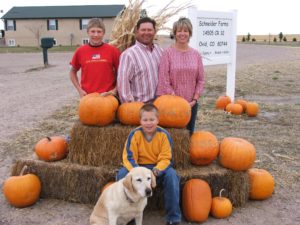
The Schneider family worked with FSA and NRCS to improve wildlife habitat and conserve water on their 2,000 acre farm in Ovid, Colorado.
By Petra Popiel, Natural Resources Conservation Service
Donny Schneider is a second-generation corn farmer from Ovid, Colorado, whose 20-year partnership with USDA has provided him with resources and expertise to grow his farm from just 300 acres to nearly 2,000 acres of land.
A Strategic Start
“My wife and I had the chance to purchase the home and land where we were living and farming,” Donny said. “That was our first 160 acres, a quarter section of the entire property and as we could, we slowly purchased more and more.”
Today, Donny has been farming with his family for 30 years. He grows corn on 1,000 acres, with most of it going to a cattle feed operation. He also sells sweet corn locally and contributes to ethanol production to help meet the rising demand for biofuels.
Solving Water Challenges
But Donny’s success hasn’t come without its challenge. Limited water resources in Colorado’s Lower South Platte watershed have made farming here difficult. Like many of his neighbors, Donny had to turn to more sustainable practices when water became scarce.
Traditional practices like flood irrigation just weren’t cutting it. Water deliveries to his crops were patchy, and the method was inefficient as it caused excessive water loss from evaporation.
That’s when he connected with local staff from USDA’s Natural Resources Conservation Service to help him find the right way to conserve water on his farm. In 2017, NRCS developed a plan to upgrade Donny to a new center pivot irrigation system. Funding from the agency’s Environmental Quality Incentives Program also helped Donny invest in a 37,000-foot underground pipeline for improved water delivery to his fields.
Now water is pumped through pipes and sprayed efficiently over his field’s surface. The system uses less water and reduces water runoff and soil erosion.
“Losing water is something we simply can’t afford to do. I know it, and the farmers and ranchers I work with know it,” shared Daniel Palic, a district conservationist with USDA’s Natural Resources Conservation Service in Julesburg and Holyoke, Colorado.

Donny is in over his head with annual sunflowers he planted through the SAFE program to enhance wildlife habitat.
Safe Places for Wildlife
This past spring, Donny also partnered with USDA’s Farm Service Agency to enroll acres of his land into their State Acres for Wildlife Enhancement initiative, which is part of the Conservation Reserve Program that helps improve habitat for wildlife. His farm was always home to an array of wildlife, including doves, some pheasants, and many other bird species. But for Donny, “There never seemed to be enough because of all the predators. So, we thought the SAFE program would get us some good habitat and give the wildlife a better chance to survive.”
He planted 18 native grasses and forbs, including species like switchgrass, little bluestem, green needlegrass, and purple prairie clover. He also planted one shrub in the seed mix called winter fat, but not before tilling his land to remove weeds and undesirable non-native species to encourage abundant plant growth.
Since working with both USDA agencies, Donny says he and his family are more conscious of their use of fertilizer and plant nutrition, and have seen a decrease in workloads, and cost benefits with more efficient water use. He looks forward to seeing the continued benefits of his conservation work this fall and winter with the improved habitat and cover he’ll see for the upland birds.
More Information
USDA offers a variety of risk management, disaster, loan, and conservation programs to help agricultural producers build resiliency and weather ups and downs in the market. Visit farmers.gov to learn more.
For more information about USDA services, contact your local USDA service center.
JOIN THE CONVERSATION
For the digital version of this blog, visit #FridaysOnTheFarm.
Follow the #FridaysOnTheFarm story series and other news you can use on farmers.gov and @Farmersgov Twitter.





